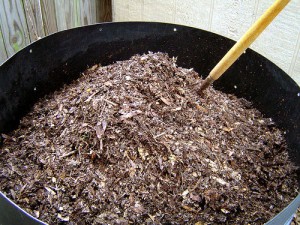Backyard composting is a great and simple way to recycle some if not all of your garden waste. All you’ll need to get started is a compost bin. Not only will you recycle your waste but you can also save money on compost by producing your own nutrient rich compost.
Positioning Your Compost Bin
Ideally your compost bin should be placed in a sunny spot on top of well drained soil. The heat from the sun will help to speed up the composting process that breaks down your organic waste while the soil base will help worms to gain access to the compost pile.

Backyard Composting
image by bunchofpants
You can place a compost bin on a concrete or paved surface however you should always add a layer of soil on the bottom first. When planting on top of soil it is a good idea to loosen the soil underneath with a fork. This will help encourage worms and useful bacteria to enter the bin.
Composting Tips
Perhaps the biggest factor of success when composting is to get a good mix of compostable materials. Ideally different types of materials should be added in thin layers of about 3-6″.
To help give your compost a boost you can buy pre bought compost starter. A much cheaper and readily available alternative is to add a little manure or even human urine to the heap to get the bacteria started!
Once your compost has started you should try and keep it moist, without being wet to help aid the bacteria. If the matter inside looks very dry add a bit of water.
Another essential composing tip for successful backyard composting is to turn your compost. Doing so ensure the matter gets broken down evenly and quickly. To do this simply take a garden fork and mix the compost inside the bin once per week.
What Can I Compost?
Vegetable & Fruit Peelings : These are excellent as they are high in both nitrogen and carbon
Tea leaves, coffee grounds & eggs shells: Again these work really well
Weeds: Most common garden weeds can be composted. For larger garden waste be sure to shred it to help speed up decomposition. Avoid certain weeds such as creeping buttercup and bindweed that will keep growing inside your bin!
Hair: Either human or pet hair can be composted!
Paper: Small amounts of paper or soft cardboard can be composted. Be sure to cut cardboard (such as egg boxes) into small pieces. Shredded paper also composts well, jsy try and avoid glossy paper such as magazines.
Grass Clippings: Grass clippings can be great for compost so long as you don’t add too much at once. As they are very high in nitrogen they can overwhelm a compost heap. A simple tip is to always try to add grass clippings at the same time as brown material such as leaves.
What Not To Compost
Meat: Do not try to compost any meat based products or scraps as this will do little apart from attract rodents.
Bread: or anything containing yeast
Cooked food: Anything that has been cooked.
i have tried a couple of copsmot bins. To be honest i have gotten the best results just making a pile and leaving it, turning it every couple of weeks. Two drawbacks in my opinion of bins is air circulation and creating a barrier for insects to enter. i had a black copsmot bin which from what i read was a popular model. The contents never got hot. This baffled me for a long time then i decided to just make a pile in a sunny area. after a good rain it gets piping hot.